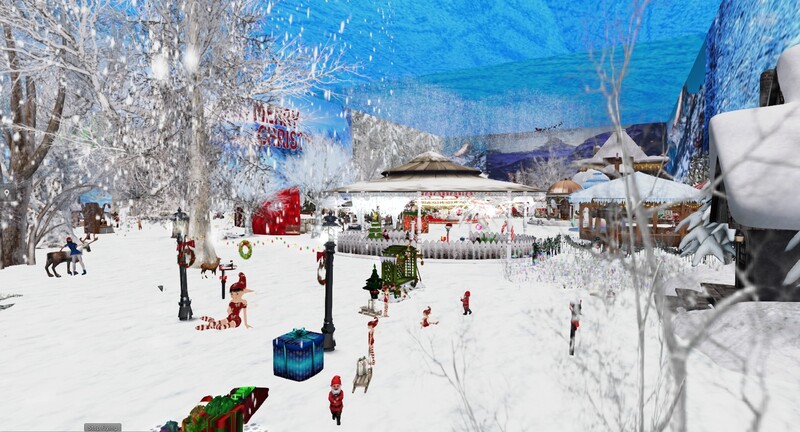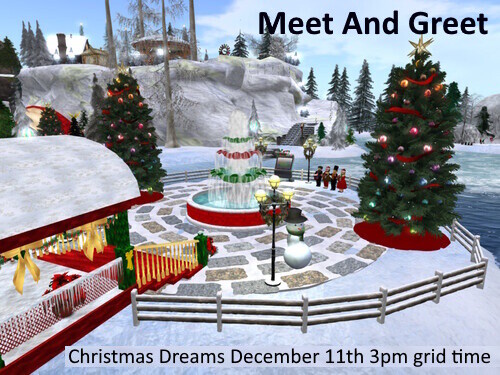Espacio

Details
- Region:
- Espacio
- Grid:
- grid.educasim.es:8002
- Rating:
- General
- Category:
- Education
- Added by :
- TrisTH
- Created :
- 3 years ago
- Traffic Rank:
- 1,887th
- Avatars in Region:
- -
A 2x2 megaregion with space technology (rockets, probes, expeditions...).
A reproduction of NBL (neutral buoyancy laboratory).
The physical testing laboratory for astronauts.
A Sky dedicated to the colonisation of Mars, another to nebulae and galaxies and a final one for astronomy classes focused on constellations.
Una megaregión 2x2 con la tecnología espacial (cohetes, sondas, expediciones..).
Una reproducción de NBL (laboratorio de flotabilidad neutra).
El laboratorio de pruebas físicas para astronautas.
Un Sky dedicado a la colonización de Marte, otro a las nebulosas y galaxias y un último para clases de astronomía enfocado a las constelaciones
Tanto la zona del espacio, como la de tecnología espacial, se encuentra a tu disposición. Si necesitas algo y está bloqueado, no dudes en avisarme
Both space and the space technology area are at your disposal. If you need something and it is blocked, don't hesitate to let me know.
Both space and the space technology area are at your disposal. If you need something and it is blocked, don't hesitate to let me know.
Hi
Make no mistake, what I like is astronomy, not rockets....
But doing this simulator (it's endless...), I'm realizing many things.
1. I have gone where I was not called.
2. The Russian-Ukrainian conflict reaches the space.
The international station, the ISS, is falling apart... The docked Soiuz has large meteorite impacts. An unmanned one will arrive on February 20 to return the astronauts to Earth (only the Russians)...
Russia has decided not to carry supplies and the ISS has to start its engines every day, to maintain orbit and not fall, plus water and food.
SpaceX has a spacecraft there, but it only holds 4 people out of the 7 that inhabit it in total. In case of emergency, if something happens before February 20, they will not be able to return in the SpaceX spacecraft either, the astronauts' suits are custom-made for each one, so the Russians could not return in it (they could not sit down for re-entry).
SpaceX will continue to carry supplies (as long as NASA pays), but we all know how Elon Musk's business is going.
NASA on the other hand, is investing in the Moon colonization project, they didn't count on fixing the ISS.... Besides, their latest plan, as they fail to land on Luna with the Orion, is to... crash the spacecraft (the necessary instruments are saved for now, they say). I'm sure this is quite economical
Will the ISS make it to 2031, when it was scheduled to be destroyed in the ocean?
My guess is that international politics will destroy it sooner.
Taking into account, that there is a new space race between SpaceX, China, Arab Emirates, USA and some crazy couple who want to go to Mars (right now nobody is able to reach the Moon and land, but they want to go to Mars...).
Why invest in Mars? Why did we go to Luna?
Hola
No os equivoquéis, lo que me gusta es la astronomía, no los cohetes....
Pero haciendo este simulador (es interminable...), me estoy dando cuenta de muchas cosas.
1. Me he metido donde no me llamaban.
2. El conflicto ruso-ucraniano llega al espacio.
3. La estación internacional, la ISS, se cae a pedazos... La Soiuz acoplada tiene grandes impactos de meteoritos. Una no tripulada llegará el 20 de febrero para devolver a los astronautas a la Tierra (sólo a los rusos)...
Rusia ha decidido no llevar suministros y la ISS tiene que encender sus motores todos los días, para mantener la órbita y no caer, además de agua y comida.
SpaceX tiene una nave allí, pero sólo caben 4 personas de las 7 que la habitan en total. En caso de emergencia, si ocurre algo antes del 20 de febrero, tampoco podrán volver en la nave de SpaceX, los trajes de los astronautas están hechos a medida para cada uno, por lo que los rusos no podrían volver en ella (no podrían sentarse para la reentrada).
SpaceX seguirá llevando suministros (mientras la NASA pague), pero todos sabemos cómo va el negocio de Elon Musk.
La NASA por su parte, está invirtiendo en el proyecto de colonización de la Luna, no contaban con arreglar la ISS.... Además, su último plan, como no consigan aterrizar en Luna con la Orión, es... estrellar la nave (los instrumentos necesarios están guardados por ahora, dicen). Seguro que esto es bastante económico
¿Llegará la ISS a 2031, cuando estaba previsto que se destruyera en el océano?
Mi opinión es que la política internacional la destruirá antes.
Teniendo en cuenta, que hay una nueva carrera espacial entre SpaceX, China, Emiratos Árabes, EEUU y alguna pareja de locos que quieren ir a Marte (ahora mismo nadie es capaz de llegar a la Luna y aterrizar, pero quieren ir a Marte...).
¿Por qué invertir en Marte? ¿Por qué fuimos a Luna?
Make no mistake, what I like is astronomy, not rockets....
But doing this simulator (it's endless...), I'm realizing many things.
1. I have gone where I was not called.
2. The Russian-Ukrainian conflict reaches the space.
The international station, the ISS, is falling apart... The docked Soiuz has large meteorite impacts. An unmanned one will arrive on February 20 to return the astronauts to Earth (only the Russians)...
Russia has decided not to carry supplies and the ISS has to start its engines every day, to maintain orbit and not fall, plus water and food.
SpaceX has a spacecraft there, but it only holds 4 people out of the 7 that inhabit it in total. In case of emergency, if something happens before February 20, they will not be able to return in the SpaceX spacecraft either, the astronauts' suits are custom-made for each one, so the Russians could not return in it (they could not sit down for re-entry).
SpaceX will continue to carry supplies (as long as NASA pays), but we all know how Elon Musk's business is going.
NASA on the other hand, is investing in the Moon colonization project, they didn't count on fixing the ISS.... Besides, their latest plan, as they fail to land on Luna with the Orion, is to... crash the spacecraft (the necessary instruments are saved for now, they say). I'm sure this is quite economical
Will the ISS make it to 2031, when it was scheduled to be destroyed in the ocean?
My guess is that international politics will destroy it sooner.
Taking into account, that there is a new space race between SpaceX, China, Arab Emirates, USA and some crazy couple who want to go to Mars (right now nobody is able to reach the Moon and land, but they want to go to Mars...).
Why invest in Mars? Why did we go to Luna?
Hola
No os equivoquéis, lo que me gusta es la astronomía, no los cohetes....
Pero haciendo este simulador (es interminable...), me estoy dando cuenta de muchas cosas.
1. Me he metido donde no me llamaban.
2. El conflicto ruso-ucraniano llega al espacio.
3. La estación internacional, la ISS, se cae a pedazos... La Soiuz acoplada tiene grandes impactos de meteoritos. Una no tripulada llegará el 20 de febrero para devolver a los astronautas a la Tierra (sólo a los rusos)...
Rusia ha decidido no llevar suministros y la ISS tiene que encender sus motores todos los días, para mantener la órbita y no caer, además de agua y comida.
SpaceX tiene una nave allí, pero sólo caben 4 personas de las 7 que la habitan en total. En caso de emergencia, si ocurre algo antes del 20 de febrero, tampoco podrán volver en la nave de SpaceX, los trajes de los astronautas están hechos a medida para cada uno, por lo que los rusos no podrían volver en ella (no podrían sentarse para la reentrada).
SpaceX seguirá llevando suministros (mientras la NASA pague), pero todos sabemos cómo va el negocio de Elon Musk.
La NASA por su parte, está invirtiendo en el proyecto de colonización de la Luna, no contaban con arreglar la ISS.... Además, su último plan, como no consigan aterrizar en Luna con la Orión, es... estrellar la nave (los instrumentos necesarios están guardados por ahora, dicen). Seguro que esto es bastante económico
¿Llegará la ISS a 2031, cuando estaba previsto que se destruyera en el océano?
Mi opinión es que la política internacional la destruirá antes.
Teniendo en cuenta, que hay una nueva carrera espacial entre SpaceX, China, Emiratos Árabes, EEUU y alguna pareja de locos que quieren ir a Marte (ahora mismo nadie es capaz de llegar a la Luna y aterrizar, pero quieren ir a Marte...).
¿Por qué invertir en Marte? ¿Por qué fuimos a Luna?
 | Ellen: Very interesting stories! 3 years ago |
The satellite space race / La carrera espacial de satelites
End of World War II
- AMERICA gets Nazi developers of the V2, von Braun's equipment.
- The V2 factory is located on German land belonging to RUSSIA and obtains a model of the V2.
- The V2 is launched in Russia and explodes.
- Russia develops a new rocket with detachable modules.
- It is revealed that SS Commandant von Braun directly selected Jewish slaves to work as slaves in the V2 factory
The cold war begins, Sergei Korolev, the chief designer of the Soviets and his team are in hiding and isolated from the world.
are hidden and isolated from the world (they do not exist and if they do, they will return to the Gulag).
Meanwhile, von Braun and his Nazi team in America are ignored.
- 1952 America decides to drop the bombs with submarines and planes.
- Russia does the same
- America limits the range and size of the rockets it designs even for military missiles.
- Russia designs the R7, but is only allowed to send bombs.
- Von Braun gets help from the Disney company and sells his space idea on television. Social pressure causes the U.S. government to create a space plan.
- Russia still fails to launch satellites
- U.S. decides to give the satellite contract to the Navy and not von Braun.
- Sergei Korolev convinces his government to do the same (finally).
BOTH SIDES TEST INCREASINGLY POWERFUL NUCLEAR BOMBS.
- The American Jupiter C created by von Braun's team reaches altitude to put satellites on it, but... that contract is with the U.S. Navy.
- The Russian R7 also explodes.
-Despite von Braun's success, he is still denied satellite launches. And he hides parts of his rocket in the hope that the Navy will fail.
- The Russian R7 is christened by pissing on it (Russian custom). It disintegrates in a few seconds. After 3 attempts, they launch it again and it fails again.
They only give it one more chance.
- Last launch attempt. It reaches 6000 km, farther than the Americans.
He is given permission to launch an R7 with the Sputnik satellite, which will demonstrate to everyone with an audible signal, that he is in space.
Russia wins the satellite race. The first man-made object to orbit the earth.
(sorry for my bad English)
Finales de la Segunda guerra Mundial
- AMERICA consigue a los desarrolladores nazis de los V2
- La fábrica de los V2 queda en terreno alemán que pertenece a RUSIA y consigue un
modelo del V2
- Lanzan elV2 en Rusia y estalla
- Rusia desarrollan un nuevo cohete con módulos que se separan
- Se desvela que Wernher von Braun, comandante de las SS escogió directamente
a esclavos judíos para trabajar como esclavos en la fabrica de la V2
Comienza la guerra fría, Sergei Korolev, el diseñador jefe de los soviéticos y su equipo
son ocultados y aislados del mundo (no existen y si existen, volverán al Gulag)
Mientras, a von Braun y a su equipo nazi en América, los ignoran
- 1952 América decide lanzar las bombas por submarinos y aviones
- Rusia también lo hace
- América limita el alcance y tamaño de los cohetes que diseñan incluso para misiles militares
- Rusia diseña el R7, pero solo le dejan enviar bombas
-von Braun consigue la ayuda de la compañía Disney y vende su idea espacial por TV. La
presión social hace que el gobierno americano cree un plan espacial
- Rusia sigue sin querer lanzar satélites
- América decide dar el contrato de satélites a la marina, no a Von Braun
-Sergei Korolev convence a su gobierno en hacer lo mismo (por fin).
AMBOS BANDOS PRUEBAN CADA VEZ MAS BOMBAS NUCLEARES MÁS POTENTES
- El Júpiter C estadounidense creado por el equipo de von Braun alcanza altitud para
colocar satélites en él, pero... ese contrato es con la Marina estadounidense.
- El R7 Ruso también explota.
-A pesar del éxito de Von Braun, se le sigue negando el lanzamiento de satélites.
Y esconde partes de su cohete con la esperanza de que la Marina falle.
- El R7 ruso es bautizado orinando sobre él (costumbre rusa). Se desintegra en pocos
segundos. Después de 3 intentos, lo lanzan de nuevo y vuelve a fallar.
Sólo le dan una oportunidad más.
- Último intento de lanzamiento. Alcanza 6000 km, más lejos que los americanos.
Le dan permiso para lanzar un R7 con el satélite Sputnik, que demostrará a todo el mundo
con una señal audible, que está en el espacio.
Rusia, gana la carrera de satélites. El primer objeto hecho por el hombre, que orbita la tierra.
To Laika and all the four-legged astronauts who have flown in Space
"The more time passes, the more I regret what happened. We shouldn't have done it... we didn't even learn enough from this mission to justify the loss of the animal."
Oleg Gazenko, one of the leading scientists in the space animal programme, and Laika's trainer, commented.
Laika was only two years old and before she was collected for the space programme she had known nothing but the cold of the Moscow streets. Before the launch, Yazdovsky wanted to give her a little happiness and took her home to play with his children: "I wanted to do something good for her, as she had very little time left to live.
Vladimir Yazdovsky made the final selection of dogs and designated their roles. Laika was to be the "flying dog" - a sacrifice to science on a one-way mission into space. Albina, who had already flown twice in a high-altitude test rocket, was designated as Laika's backup. The third dog, Mushka, was a "control dog" - she would stay on the ground and was used to test instrumentation and life support.
Laika was placed in the satellite capsule on 31 October 1957 - three days before the start of the mission. At that time of year, temperatures at the launch site were extremely low, so a hose connected to a heater was used to keep the container warm. Two assistants were in charge of keeping a constant watch over Laika before the start of the mission. Just before take-off on 3 November 1957, Laika's coat was cleaned with an ethanol solution, and those areas where the dog would wear sensors to monitor her bodily functions were painted with iodine.
One of the technicians who prepared the capsule before the final liftoff stated that "after Laika was placed in the container and before the hatch was closed, we kissed her nose and wished her bon voyage, knowing that she would not survive the flight."
Laika died hours after launch from overheating, which was probably caused by a failure of the R-7 central sustainer, part of the spacecraft's thermal system, to separate from the payload. The true cause and time of her death was not revealed until 2002; instead, it was widely reported that she had died on the sixth day,4 ran out of oxygen, or as the Soviet government initially claimed, was euthanised before oxygen depletion. The experiment demonstrated that it is possible for a living passenger to survive being put into orbit and endure microgravity, paving the way for human spaceflight and providing scientists with some of the first data on how living organisms react to spaceflight environments. Following Laika, the USSR sent eight more dogs into space, six of which returned alive to Earth.
Sputnik 2 was not designed to be retrievable, and it was always intended that Laika would die. The mission sparked a worldwide debate about the mistreatment of and experiments on animals to advance science. In the UK, the National Canine Defence League (NCDL, now the Dog Foundation) called for dog owners to observe a minute's silence in Laika's honour. The Royal Society for the Prevention of Cruelty to Animals (RSPCA) received protests even before Radio Moscow had finished announcing the launch. Several animal rights groups protested outside Soviet embassies, others demonstrated outside the United Nations in New York, but some American scientists offered support to their Soviet colleagues, at least before Laika's death was announced.
----------------------
A Laika y a todos los astronautas de 4 patas que llegaron al Espacio
«Cuanto más tiempo pasa, más lamento lo sucedido. No debimos haberlo hecho... ni siquiera aprendimos lo suficiente de esta misión como para justificar la pérdida del animal.»
Comentó Oleg Gazenko, uno de los principales científicos del programa de animales en el espacio, y entrenador de Laika
Laika tenía solo dos años y antes de ser recogida para el programa espacial no había conocido más que el frío de las calles moscovitas. Antes del lanzamiento, Yazdovsky quiso obsequiarla con un poco de felicidad y se la llevó a su casa para que jugara con sus hijos: “Quería hacer algo bueno por ella, ya que le quedaba muy poco tiempo de vida”.
Vladimir Yazdovsky hizo la selección final de perros y designó sus roles. Laika iba a ser la «perra voladora» —un sacrificio a la ciencia en una misión de ida al espacio. Albina, que ya había volado dos veces en un cohete de prueba a gran altura, se designó como reserva de Laika. El tercer perro, Mushka, era un «perro de control» -se quedaría en tierra y era usada para probar la instrumentación y el soporte vital.
Laika fue colocada en la cápsula del satélite el 31 de octubre de 1957 —tres días antes del inicio de la misión. En esa época del año, las temperaturas en el sitio de lanzamiento eran extremadamente bajas, por lo que se usó una manguera conectada a un calentador para mantener caliente el contenedor. Dos asistentes estaban encargados de vigilar constantemente a Laika antes del comienzo de la misión. Justo antes del despegue, el 3 de noviembre de 1957, se limpió el pelaje de Laika con una solución de etanol, y le pintaron con yodo aquellas áreas donde la perra llevaría sensores para vigilar sus funciones corporales.
Uno de los técnicos que preparó la cápsula antes del despegue final declaró que «después de la colocación de Laika en el contenedor y antes de cerrar la escotilla, le besamos la nariz y le deseamos buen viaje, sabiendo que no iba a sobrevivir al vuelo.»
Laika murió horas después del lanzamiento por sobrecalentamiento, que probablemente fue ocasionado por un fallo del sustentador de la central R-7, que forma parte del sistema térmico de la nave, al separarse de la carga útil. La verdadera causa y tiempo de su muerte no fue revelada sino hasta 2002; en cambio, fue ampliamente informado que había muerto al sexto día, se quedó sin oxígeno, o como el gobierno soviético alegó inicialmente, fue sometida a eutanasia antes del agotamiento del oxígeno. El experimento demostró que es posible que un pasajero vivo sobreviva al ser puesto en órbita y soportar la microgravedad, allanando el camino para los vuelos espaciales humanos y proporcionando a los científicos algunos de los primeros datos sobre cómo los organismos vivos reaccionan a los entornos de los vuelos espaciales. Tras Laika, la URSS envió ocho perros más al espacio, de los cuales seis regresaron con vida a la Tierra
El Sputnik 2 no fue diseñado para ser recuperable, y siempre se tuvo la intención de que Laika muriera. La misión desencadenó un debate mundial sobre el maltrato y los experimentos con animales para avanzar en la ciencia. En el Reino Unido, la Liga Nacional de Defensa Canina (NCDL, actualmente Fundación para los Perros) pidió que los dueños de perros guardaran un minuto de silencio en honor a Laika. La Real Sociedad para la Prevención de la Crueldad contra los Animales (RSPCA) recibió protestas incluso antes de que Radio Moscú hubiera terminado de anunciar el lanzamiento. Varios grupos protectores de los derechos animales protestaron frente a embajadas soviéticas. Otros se manifestaron frente a las Naciones Unidas en Nueva York; sin embargo, algunos científicos estadounidenses ofrecieron apoyo a sus colegas soviéticos, por lo menos antes de que se anunciara la muerte de Laika.
"The more time passes, the more I regret what happened. We shouldn't have done it... we didn't even learn enough from this mission to justify the loss of the animal."
Oleg Gazenko, one of the leading scientists in the space animal programme, and Laika's trainer, commented.
Laika was only two years old and before she was collected for the space programme she had known nothing but the cold of the Moscow streets. Before the launch, Yazdovsky wanted to give her a little happiness and took her home to play with his children: "I wanted to do something good for her, as she had very little time left to live.
Vladimir Yazdovsky made the final selection of dogs and designated their roles. Laika was to be the "flying dog" - a sacrifice to science on a one-way mission into space. Albina, who had already flown twice in a high-altitude test rocket, was designated as Laika's backup. The third dog, Mushka, was a "control dog" - she would stay on the ground and was used to test instrumentation and life support.
Laika was placed in the satellite capsule on 31 October 1957 - three days before the start of the mission. At that time of year, temperatures at the launch site were extremely low, so a hose connected to a heater was used to keep the container warm. Two assistants were in charge of keeping a constant watch over Laika before the start of the mission. Just before take-off on 3 November 1957, Laika's coat was cleaned with an ethanol solution, and those areas where the dog would wear sensors to monitor her bodily functions were painted with iodine.
One of the technicians who prepared the capsule before the final liftoff stated that "after Laika was placed in the container and before the hatch was closed, we kissed her nose and wished her bon voyage, knowing that she would not survive the flight."
Laika died hours after launch from overheating, which was probably caused by a failure of the R-7 central sustainer, part of the spacecraft's thermal system, to separate from the payload. The true cause and time of her death was not revealed until 2002; instead, it was widely reported that she had died on the sixth day,4 ran out of oxygen, or as the Soviet government initially claimed, was euthanised before oxygen depletion. The experiment demonstrated that it is possible for a living passenger to survive being put into orbit and endure microgravity, paving the way for human spaceflight and providing scientists with some of the first data on how living organisms react to spaceflight environments. Following Laika, the USSR sent eight more dogs into space, six of which returned alive to Earth.
Sputnik 2 was not designed to be retrievable, and it was always intended that Laika would die. The mission sparked a worldwide debate about the mistreatment of and experiments on animals to advance science. In the UK, the National Canine Defence League (NCDL, now the Dog Foundation) called for dog owners to observe a minute's silence in Laika's honour. The Royal Society for the Prevention of Cruelty to Animals (RSPCA) received protests even before Radio Moscow had finished announcing the launch. Several animal rights groups protested outside Soviet embassies, others demonstrated outside the United Nations in New York, but some American scientists offered support to their Soviet colleagues, at least before Laika's death was announced.
----------------------
A Laika y a todos los astronautas de 4 patas que llegaron al Espacio
«Cuanto más tiempo pasa, más lamento lo sucedido. No debimos haberlo hecho... ni siquiera aprendimos lo suficiente de esta misión como para justificar la pérdida del animal.»
Comentó Oleg Gazenko, uno de los principales científicos del programa de animales en el espacio, y entrenador de Laika
Laika tenía solo dos años y antes de ser recogida para el programa espacial no había conocido más que el frío de las calles moscovitas. Antes del lanzamiento, Yazdovsky quiso obsequiarla con un poco de felicidad y se la llevó a su casa para que jugara con sus hijos: “Quería hacer algo bueno por ella, ya que le quedaba muy poco tiempo de vida”.
Vladimir Yazdovsky hizo la selección final de perros y designó sus roles. Laika iba a ser la «perra voladora» —un sacrificio a la ciencia en una misión de ida al espacio. Albina, que ya había volado dos veces en un cohete de prueba a gran altura, se designó como reserva de Laika. El tercer perro, Mushka, era un «perro de control» -se quedaría en tierra y era usada para probar la instrumentación y el soporte vital.
Laika fue colocada en la cápsula del satélite el 31 de octubre de 1957 —tres días antes del inicio de la misión. En esa época del año, las temperaturas en el sitio de lanzamiento eran extremadamente bajas, por lo que se usó una manguera conectada a un calentador para mantener caliente el contenedor. Dos asistentes estaban encargados de vigilar constantemente a Laika antes del comienzo de la misión. Justo antes del despegue, el 3 de noviembre de 1957, se limpió el pelaje de Laika con una solución de etanol, y le pintaron con yodo aquellas áreas donde la perra llevaría sensores para vigilar sus funciones corporales.
Uno de los técnicos que preparó la cápsula antes del despegue final declaró que «después de la colocación de Laika en el contenedor y antes de cerrar la escotilla, le besamos la nariz y le deseamos buen viaje, sabiendo que no iba a sobrevivir al vuelo.»
Laika murió horas después del lanzamiento por sobrecalentamiento, que probablemente fue ocasionado por un fallo del sustentador de la central R-7, que forma parte del sistema térmico de la nave, al separarse de la carga útil. La verdadera causa y tiempo de su muerte no fue revelada sino hasta 2002; en cambio, fue ampliamente informado que había muerto al sexto día, se quedó sin oxígeno, o como el gobierno soviético alegó inicialmente, fue sometida a eutanasia antes del agotamiento del oxígeno. El experimento demostró que es posible que un pasajero vivo sobreviva al ser puesto en órbita y soportar la microgravedad, allanando el camino para los vuelos espaciales humanos y proporcionando a los científicos algunos de los primeros datos sobre cómo los organismos vivos reaccionan a los entornos de los vuelos espaciales. Tras Laika, la URSS envió ocho perros más al espacio, de los cuales seis regresaron con vida a la Tierra
El Sputnik 2 no fue diseñado para ser recuperable, y siempre se tuvo la intención de que Laika muriera. La misión desencadenó un debate mundial sobre el maltrato y los experimentos con animales para avanzar en la ciencia. En el Reino Unido, la Liga Nacional de Defensa Canina (NCDL, actualmente Fundación para los Perros) pidió que los dueños de perros guardaran un minuto de silencio en honor a Laika. La Real Sociedad para la Prevención de la Crueldad contra los Animales (RSPCA) recibió protestas incluso antes de que Radio Moscú hubiera terminado de anunciar el lanzamiento. Varios grupos protectores de los derechos animales protestaron frente a embajadas soviéticas. Otros se manifestaron frente a las Naciones Unidas en Nueva York; sin embargo, algunos científicos estadounidenses ofrecieron apoyo a sus colegas soviéticos, por lo menos antes de que se anunciara la muerte de Laika.
 | Jerralyn Franzic: Lovely space sim you have here! Perfect for people overwhelmed with the giant space sims, like the ISM ones in Kitely and SL. :) 3 years ago |




